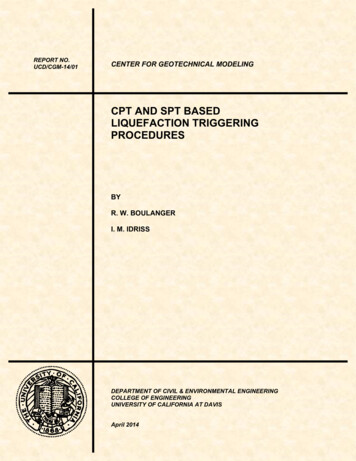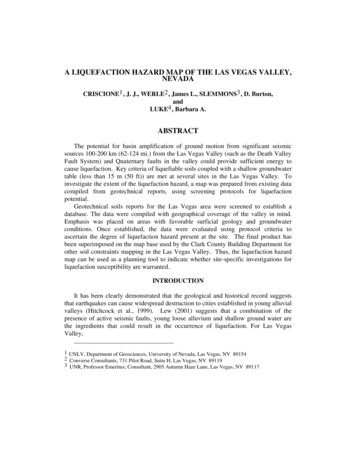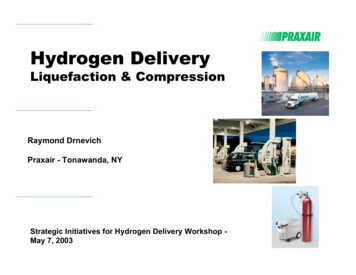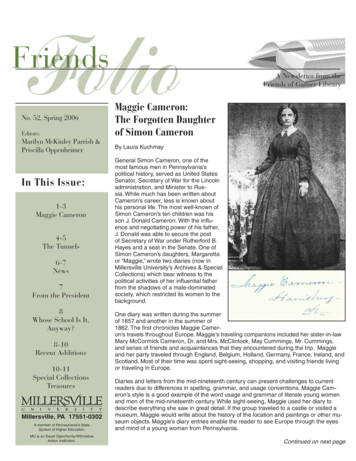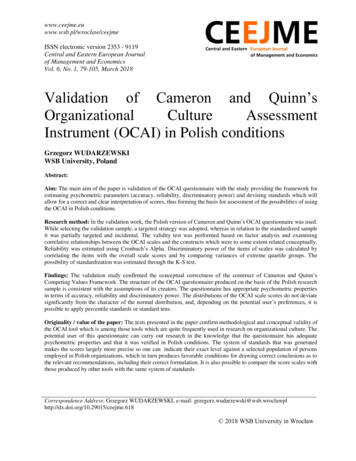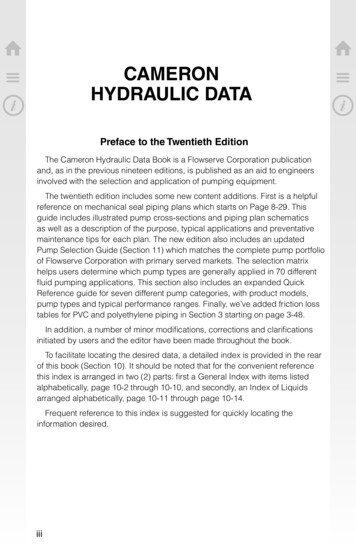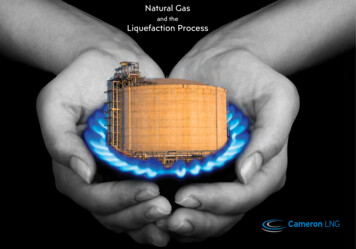
Transcription
Natural Gasand theLiquefaction Process
TableCameron LNGContents. . . . . . . . . . . . . . . . . . . . 2Liquefied Natural GasLNG Safetyof. . . . . . . . . . . . . . . . 4. . . . . . . . . . . . . . . . . . . . . . 5Environmental Safety. . . . . . . . . . . . . . . . 6Liquid Properties. . . . . . . . . . . . . . . . . . 7Vapor Properties. . . . . . . . . . . . . . . . . . 8The Liquefaction ProcessLNG StorageTransportation. . . . . . . . . . . . . 9. . . . . . . . . . . . . . . . . . . . . 13. . . . . . . . . . . . . . . . . . . . 15Receiving TerminalsThe Illustrated Gas Chain. . . . . . . . . . . . . . . . 16. . . . . . . . . . . . . 171
Cameron LNGCameron LNGA small local footprint with global impactCameron LNG exists to liquefy natural gas for our customers.Our work is to do this consistently, to do it well and to do it safelyover time. We work with a sense of responsibility to our employees,our communities, our stakeholders and the environment in whichwe operate.Cameron LNG is headquartered in Houston and our liquefactionfacility is in southwest Louisiana. The facility is cradled by theCalcasieu River in the midst of peaceful marsh and swamp landjust 18 miles north of the Gulf of Mexico.Our name is derived from Cameron Parish, which is known forits many lakes, wildlife refuges and natural beauty. CameronParish is also the largest of Louisiana’s parishes with 1,313 squaremiles of land and 619 square miles of water inhabited by reptilesof all sorts, fresh and saltwater wildlife, over 400 bird species,sportsmen of all types and local families. Cameron LNG has madea commitment to safeguard the environment in which we operate,and we hold that responsibility as sacrosanct.Cameron LNG’s partners are Sempra LNG & Midstream, Mitsui &Co., Mitsubishi Corporation, ENGIE, and NYK line. Together, thesecompanies represent extensive LNG and market experience.2
Cameron LNG(continued)Cameron LNGOur two-berth, three tank facility became part of the community and commercially operated in 2009.In 2014, the partners committed an estimated 10 billion to construct a liquefaction facility. Once fullyoperational, we will be able to liquefy domestically-produced natural gas for export, import liquefiednatural gas (LNG) and regasify it for delivery to domestic markets and re-export foreign-sourced LNG.Our three-train project has been granted approval to export an annual 14.95 Mtpa, which will have manybenefits, both locally and globally. Locally, new jobs and economic prosperity have been created in theregion. Globally, we will supply America’s trading partners with access to stable supplies of liquefiednatural gas.Historically, you can find references to natural gas dating back to 1,000 B.C. With advances in technologythe U.S. currently has an estimated 100-year supply of shale gas. The process of liquefying natural gas iscomparatively new and was only discovered in 1820. The first LNG plant was built in 1912 and LNG shippingbegan around 1959. Still, many myths and misconceptions persist in the general public about LNG. Weassembled this book in hope of dispelling some myths, correcting others and enlightening all. We hopeyou enjoy the book and gain a more complete understanding of LNG.3
Liquefied Natural GasWhat is LNG?Liquefied natural gas is gas that has been cooled to -260 F (-160 C) and converts to a liquid state. Whennatural gas is in a liquid form, it takes up approximately 1/600th of the space it would as a vapor, makingtransportation much more efficient and economical.NATURAL GAS AND LNGLNG is mostly methane plus a small percentof ethane, propane and butane, and traceamounts of nitrogen.When natural gas is liquefied, there isa 600% reduction in volume.Ethane, propane, butaneand nitrogen 5–15%600:1 ratioMethane 85–95%The same amount of natural gasthat would fill a beach ball.can fit in a golf ballwhen liquefied.4
LNG SafetyIs it safe?LNG is very safe to transport, and the industry’s safety record is exemplary. For over 50 years, LNG hasbeen safely transported around the world in tankers. LNG is an odorless, non-toxic, non-corrosive liquidand leaves no residue after it evaporates. LNG will not ignite until it becomes a vapor, and even then thevapor won’t ignite until it mixes with air and becomes extremely diluted (5- 15% vaporized gas-to-air ratio).Below 5% there is too little gas in the air to burn; above 15%, there is not enough oxygen. Tests conductedby the Sandia National Laboratories for the U.S. Department of Energy demonstrate that unconfined LNGvapor clouds do not detonate, they only burn.Oxygen %LNG mableareaMixture of Methaneand air cannotexist abovethis lineToo muchoxygen01020Not capable offorming flammablemixture with this air5Too muchoxygenOnly flammableToo muchin 5-15%methanemixture304050607080Methane %90100Too muchmethaneMethane is only flammable when mixedwith oxygen in a 5-15% methane-to-oxygen ratio
Environmental SafetyWhat if there is a release?LNG is safely transported by sea because every precaution is taken to mitigate the possibility of a release.If there were a release, vaporizing LNG is not soluble in water and any liquid released on land or in theocean would quickly evaporate. There is no possibility for land or water contamination. LNG is non-toxicand it does not chemically react unless it is ignited.LNG pouredinto fish tankWatertemperaturedropsFish swim awayand are safe6
Liquid PropertiesLNG as a liquid Looks like mineral waterStored as a liquid in well-insulated tanks at near atmospheric pressureDoes not absorb into the groundFloats on water then vaporizes (all that’s left is ice)Large spills on water may produce rapid phase transition (non-combustion explosion)LNG pouredinto cupbegins tovaporizeWaterfreezeson topDoes notbreak glass7
Vapor PropertiesLNG as a vapor Looks like fogLighter than air, rises and dispersesLeaves no residue on land or waterCloud flammable only when gas is within 5-15% rangeNon-explosive unless ignited in confined space8
The Liquefaction ProcessHow is natural gas liquefied?Natural gas is converted to a liquid in a liquefaction plant,or “train”. An LNG train performs three main processes:1. PretreatmentDust and slug (water and condensate) is removed alongwith hydrogen sulfide (H2S) and mercury (Hg). Thesepollutants can cause corrosion and freezing problems,especially in aluminum heat exchangers.2. Acid Gas Removal and DehydrationCarbon dioxide (CO2) is absorbed and removed fromnatural gas with an amine absorber (acid gas removal orAGR) and an adsorbent is used to remove water. Theseimpure substances are removed so that ice will not formduring the subsequent liquefaction process.3. Heavy Hydrocarbon Separation and LiquefactionHeavy hydrocarbons (C5 ) are removed by fractionationbefore liquefaction. As shown in the liquefaction processschematic, natural gas is pre-cooled to about-31 F (-35 C) by propane.Cameron LNG Train 1 – October 20169
Temp. Ranges 100 F 38 CTemp. Ranges 60 to 85 F 16 to 29 CTemp. Ranges 85 to 54 F 29 to 12 CTemp. Ranges 98 to 54 F 37 to 12 CTemp. Ranges 195 to -31 F 91 to -35 CGas Meteringand PressureControlMercuryRemoval andH2S ScavengerCO2 Removaland GasDehydrationGas Chilling andHeavy HydrocarbonRemoval 104 F 40 CTemp. RangesHeavy HydrocarbonTruck LoadingTemp. Ranges-256 F-160 CGasWarmerFuel GasNaturalGasFeedTemp. Ranges 314 F 157 CPropaneRefrigerationSystemBlow-offGasTemp. Ranges-31 to -260 F-35 to -162 CLiquefactionand End FlashGasMixedRefrigerationSystemLNGStorage-260 F-162 CTemp. Ranges 113 F 145 CTemp. Ranges10
The Liquefaction Process(continued)After pre-cooling, natural gas moves through a tube circuit in the main cryogenic heat exchanger (MCHE)where it is liquefied and sub-cooled to between -238 F (-150 C) to -260 F (-162 C) by mixed refrigerant (MR).The MR is also pre-cooled and then separated in a high pressure separator. The vapor and liquid streams passthrough separate tube circuits in the MCHE where they are further cooled, liquefied, and sub-cooled.The two sub-cooled streams are let down in pressure, further reducing their temperatures. As the mixedrefrigerant vaporizes and flows downward on the shell side of the MCHE, it provides refrigeration forliquefying and sub-cooling the natural gas. The LNG end flash at the outlet of the MCHE and in the receivingLNG storage tank generates flash gas and boil-off gas to make up the fuel gas needed mainly by the propaneand MR gas turbine driven compression cycles.Train 1 – April 19, 201711
LNG-260 F-162 C-238 F-150 CPropane-31 F-35 CMCHE(Main Cryogenic Heat Exchanger)MR VaporFeed 104 F 40 CPropanePre-coolingMR CompressorMR LiquidMixed Refrigerant12
LNG StorageHow is LNG stored?LNG is stored in full-containment tanks,which typically have a capacity of 160,000m3. LNG tank pressures are kept at justabove one atmosphere.Full-containment systems have two tanks,an inner one for the product and an outerone providing security against leakage.The inner shell is made of a special nickelalloy designed to resist low temperatures,and the outer shell is pre-stressedconcrete with a reinforced slab and roof.Each tank is insulated to maintain LNGat approximately -256 F (-160 C) andhas sophisticated automatic protectionsystems to monitor the tank level,pressure, temperature and anypotential leakage.Roof LinerOuter Concrete RoofSuspensionRodPerlite PowderRoofInsulationPC WallGlass Fiber BlanketWall LinerWall InsulationSuspensionDeckPC WallInner WallAnnular PlateCornerProtectionCorner ProtectionInner BottomFoundation SlabBottom VaporBarrierSecondary BottomBottom Insulation13OuterConcrete RoofBottom Heater
terRoof LinerOuterConcrete RoofSuspensionRodRoofInsulationPC WallStairsSuspension DeckInner WallSuspensionDeckInner WallPump BarrelWall InsulationInner BottomAnnular PlateCornerProtectionInner BottomBottom InsulationSecondary BottomBottom VaporBarrierFoundation Slab14
TransportationHow is LNG transported?LNG is transported in special double-hull ships. The most commonly used cargo-tank types areMembrane cargo tanks that are supported by the ship’s hull and Type B Spherical (Moss) tanks that areself-supporting. Each type of cargo tank uses cryogenic materials for containment that are insulated toreduce the cargo boil-off to less than 0.15 percent per day. The LNG is off-loaded from the jetty to terminalstorage tanks, which takes approximately 14-16 hours. The LNG remains at -160 C for the duration of theprocess. LNG has been transported commercially by ships since 1964 and as of the end of 2016 there havebeen 88,000 cargoes or 176,000 voyages without an LNG loss.“Membrane” LNG VesselA 155,000 m3 membrane vessel isapproximately the same size vesselas our average base cargo. This vessel is:Length 946.29 feet (288.43 meters)Breadth 145.14 feet (44.24 meters)Draft 37.73 feet (11.5 meters)15
Receiving TerminalsHow is LNG turned into gas?LNG is reheated with at least one heat exchanger and converted to gas using one of two commonmethods. In one technique, a small amount of the LNG is burned in a submerged combustion vaporizer,which produces the heat needed to gasify the remaining LNG.The second method uses open rack vaporizers to gasify LNG with heatfrom ambient water, such as seawater or river water. LNG entersfrom the lower part of the vaporizer heat exchanger andexits as gas from the upper part.The water is collected andeventually returnedto its source.“Moss” LNG Vessel16
LNG Gas ChainLiquefactionShippingGas to LNGGas to MarketMid-stream Gathering17Regasification
Power GenerationTransmissionEnd UsersConsumerIndustrialDistribution18
HeaderBody HeadBody copy19
HeaderBody HeadBody copyRendering, from north looking south20
HeaderBody HeadBody copy21From south looking north 2017, 04-19
HeaderBody HeadBody copyRendering, from east looking west22
HeaderBody HeadBody copy23From east looking west 2017, 04-19
HeaderBody HeadBody copyLoading arms24
HeaderBody HeadBody copy25Tanks at sunset
HeaderBody HeadBody copyFrom east looking west 2017, 04-2826
HeaderBody HeadBody copy27From south looking north 2017, 04-19
HeaderBody HeadBody copy1st Cargo 2009, 06-2628
HeaderBody HeadBody copy29From north looking south 2017, 04-19
2925 Briarpark DriveSuite 1000Houston, TX 77042(832) 783-5500301 Main StreetGate “A”Hackberry, Louisiana 70645(337) 680-4677
Natural gas is converted to a liquid in a liquefaction plant, or "train". An LNG train performs three main processes: 1. Pretreatment. Dust and slug (water and condensate) is removed along with hydrogen sulfide (H. 2. S) and mercury (Hg). These pollutants can cause corrosion and freezing problems, especially in aluminum heat exchangers. 2.


